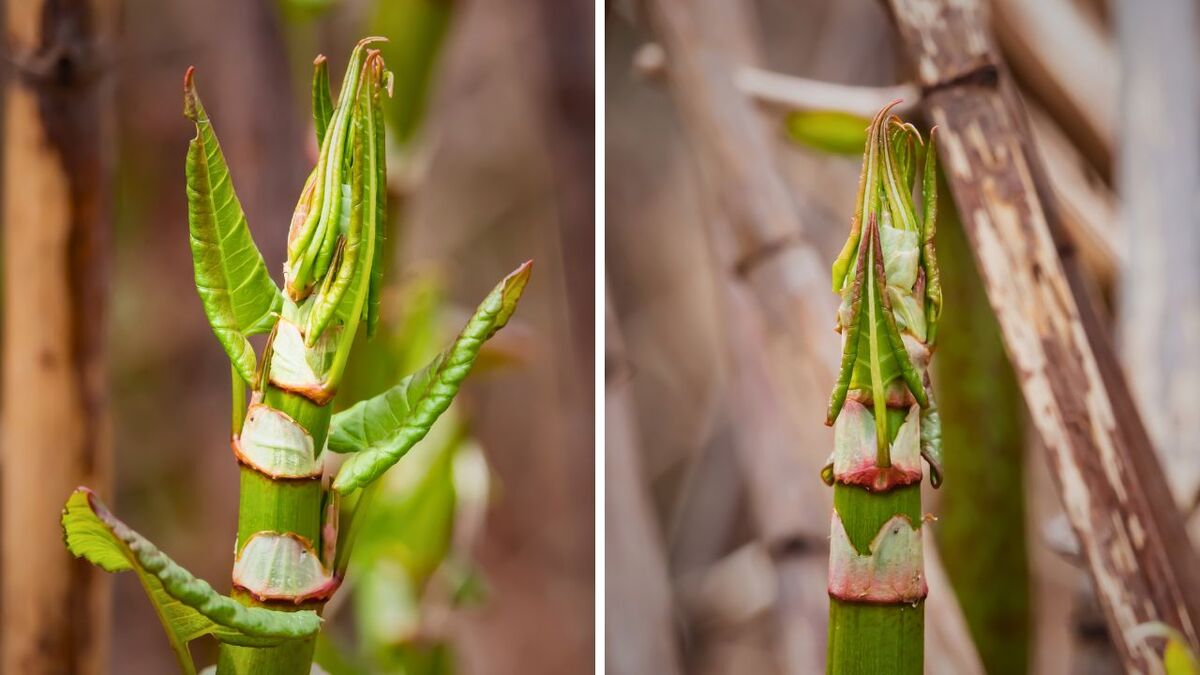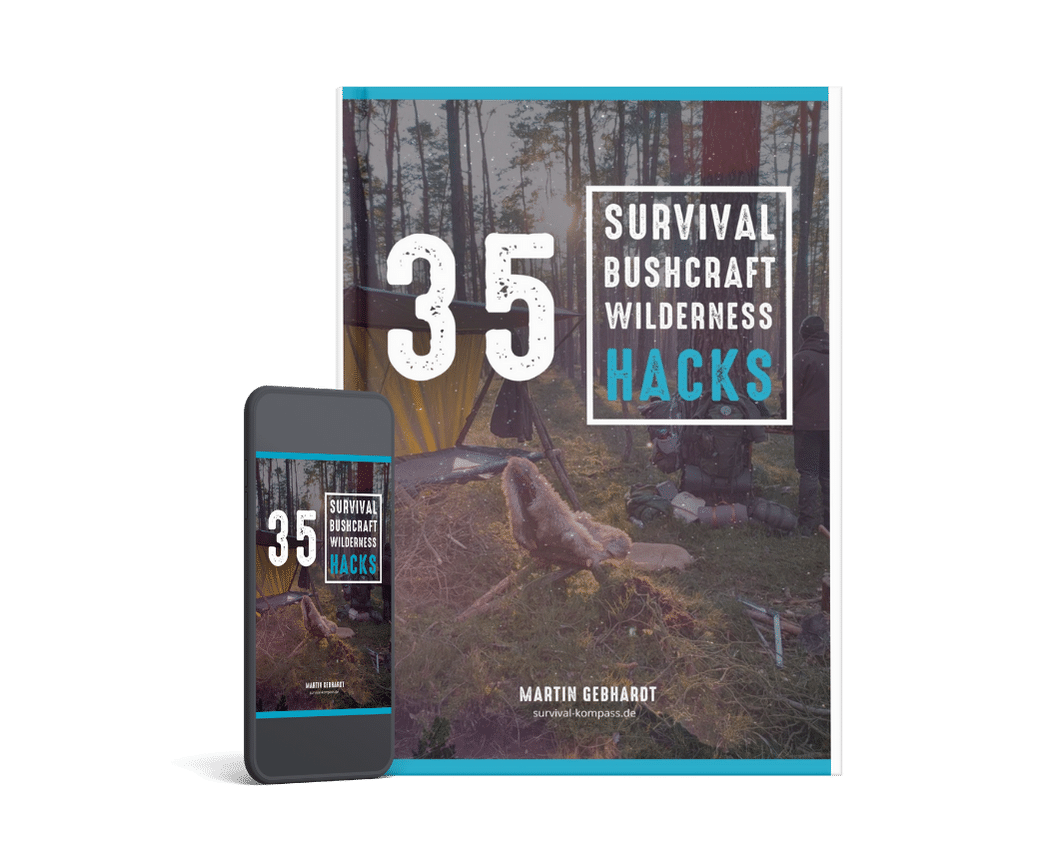
Japanese knotweed: Eat it instead of fighting it Your survival guide
👉 The key facts from this guide
- The Japanese knotweed is invasive, hardly eradicated – and yet edible! Instead of fighting it: Just eat it up!
- Only the young, tender shoots in spring (April–May) are suitable for consumption – they taste reminiscent of tart rhubarb.
- Important: Do not confuse with the highly toxic giant hogweed! It can cause severe skin reactions upon contact – 100% sure identification!
- In the kitchen, knotweed makes a good impression: as compote, in cakes, chutneys, or even savory pickled – super versatile!
- Raw consumption is possible, but due to the contained oxalic acid, it is better to eat it cooked – it is more digestible and safer.
- When foraging, please do not spread any rhizome pieces – it will otherwise spread further. Responsibility, respect, and clean shoes are a must!
Do you know these plants that are just everywhere? That seem to spread overnight and conquer entire regions?
Yes, I'm talking about Japanese knotweed (Reynoutria japonica or Fallopia japonica). For many gardeners and conservationists, it is the ultimate enemy – invasive, nearly impossible to stop, and somehow… threatening.
But wait! Before you whip out the machete (which usually doesn't help anyway), let's take a different perspective.
What if I told you that this green "Aggressor" can be quite an exciting survival food and an underrated delicacy? Sounds crazy? It is – but in a good way!
As a wilderness educator and Bushcrafter, I love discovering the hidden potentials of nature. And the Japanese knotweed? It definitely has potential!
From Problem Child to Plate Hero – Eating Instead of Fighting?
Okay, let's be honest: The Japanese knotweed is an invasive species. It displaces native plants and can even break through asphalt. That's a fact and should not be sugar-coated.

BUT: If it's already there and multiplying like crazy, why not make the best of it?
The motto "Eat the Invader" is more than fitting here. It is a kind of culinary guerrilla gardening against a plant that is hardly manageable anyway.
When and What? The Perfect Harvest Time for Tender Shoots
Here comes the catch: Timing is everything! Forget the huge, woody stems that look like bamboo forests in summer. They are tough as shoe soles.
What we want are the young, tender shoots in spring – usually from April to early May, depending on the weather and location.

Imagine walking through the still bare landscape, and suddenly, you see them sprouting from the ground: reddish-green, often speckled "spears" that somewhat resemble thick asparagus.
If they are about 15–30 cm high and can still be easily scratched with a fingernail or even break (like green asparagus), then they are perfect!
As soon as they become thicker and the leaves fully unfold, they quickly become fibrous and woody. So: Go hunting early in the year!
Attention, risk of confusion! Your survival focus – vital!
Now comes the ABSOLUTELY MOST IMPORTANT PART, so please read carefully! Foraging for wild plants requires 100% certainty in identification.
With the knotweed, this is particularly tricky, as there is an extremely dangerous lookalike:
-
The Giant Hogweed (Heracleum mantegazzianum): This guy is NO joke! Its sap contains furanocoumarins, which can lead to severe, burn-like skin reactions (photodermatitis) when exposed to sunlight. A mix-up can end badly!
-
Differences in young shoots:
-
Japanese Knotweed: Shoots resemble reddish-green asparagus, are smooth, hollow, often red-spotted. The young leaves are more heart-/shield-shaped and unfold relatively smoothly. The stem has distinct nodes (hence the name!) and is surrounded by a thin membrane (ochrea) that falls off quickly. No hairs!
-
Giant Hogweed: Young shoots are typically already bristly hairy, sometimes purplish. The leaves are deeply lobed or highly divided from the start and unfold "wrinkled". The stem is regularly ribbed and also has purplish spots, but also these distinctive bristly hairs.
-
-
Later differences (for safety): Knotweed has smooth, hollow, bamboo-like stems and heart-shaped leaves. Hogweed grows huge (up to 3-5m!), has heavily hairy, thick stems and enormous, deeply cut leaves as well as large, white flower umbels.
-
-
Other possible, but less dangerous confusions:
-
Sakhalin Knotweed (Reynoutria sachalinensis): Very similar, but the leaves are larger, more heart-shaped at the base, often slightly hairy on the underside. Also considered edible.
-
Other Knotweed species (e.g., Meadow Knotweed): Usually have narrower leaves and grow differently, less "bamboo-like".
-
Dock species (Rumex): Leaves usually grow from a basal rosette and do not have bamboo-like, hollow stems with nodes.
-
Rule of thumb: If you're not 1000% sure – hands off! When in doubt, always consult an expert or refer to a good identification book. The danger posed by giant hogweed is real!

From "Weed" to Delicacy: Preparation Ideas for Adventurers
Okay, you have harvested your young, definitely determined knotweed shoots. What now?
The stuff tastes amazingly good – intensely sour, similar to rhubarb, but with its own slightly "green" note.
-
Preparation: The outer, often slightly reddish skin can be fibrous. It is advisable to peel the stalks like rhubarb or asparagus. Then cut into pieces.
-
Sweet treats (like rhubarb):
-
Compote/Purée: Simply simmer with sugar (or honey/maple syrup) and a little water. Delicious with pancakes, waffles, or yogurt.
-
Cakes & Crumbles: Use it like rhubarb in crumb cakes, pies, or crumbles. The acidity pairs wonderfully with sweet dough.
-
Jam/Chutney: Cook down with gelling sugar or in combination with fruits (strawberries!) to make jam. Or as a sour base for a spicy chutney.
-
-
Savory experiments:
-
Soups: The acidity can add an interesting note to cream soups (use sparingly!).
-
Pickled: Pickle sweet-sour like cucumbers – results in a crunchy, tangy snack.
-
(Advanced): Some even use it briefly blanched in savory dishes, but the acidity is dominant. You have to like it and combine it well!
-
-
Raw? Some nibble on very young, tender tips raw. But caution: Like rhubarb, dock contains oxalic acid. Consumed raw in large quantities is not ideal (can bind minerals and stress the kidneys). Cooked, it is more digestible.

The Bushcraft Idea: Use What Is There – With Common Sense
The Japanese knotweed is a perfect example of the bushcraft principle: Get to know your environment and use the resources it offers – including the unexpected or unpopular ones.
At the same time, it teaches us humility and the necessity of precise knowledge (identification!) and responsibility (harvest time, invasive species).
Please remember responsibility when collecting!
Even if we call it "eat instead of fight": Be careful not to spread any root parts (rhizomes), as they will grow back from them.
A small piece of rhizome in the boot profile may be enough to carry it to a new location. So only harvest the above-ground shoots and be clean. Furthermore, respect property rights and any local collection bans.

Conclusion: The Misunderstood Giant with a Sour Secret
Yes, the Japanese knotweed is invasive. But it is also a remarkable plant – a powerhouse that can provide us with an abundance of tart, vitamin-rich stalks in spring if we know how and when.
It is a culinary adventure for anyone who likes to look beyond the plate (or the wayside).
Go ahead (with the necessary caution when identifying!), experiment and perhaps discover your new favorite rhubarb substitute straight from the wild. But never forget: Safety first!
The nature is full of wonders, but it also requires our respect and knowledge.


Author of the guide
Martin Gebhardt
Hey, I'm Martin. On my blog, you will learn the basics and numerous details about living in the wild. I think survival, bushcraft and the good life in nature are the keys to happiness. Find me here on Instagram or on YouTube. You can find more about my mission on the About Me page.
Was this guide helpful?
15 people found this guide helpful.
5.00 out of 5 points (15 Ratings)
Comments (0)
This post may contain affiliate links. So if you click on the links and make a purchase, I will receive a small commission at no additional cost to you. Click here, to learn more about it.


